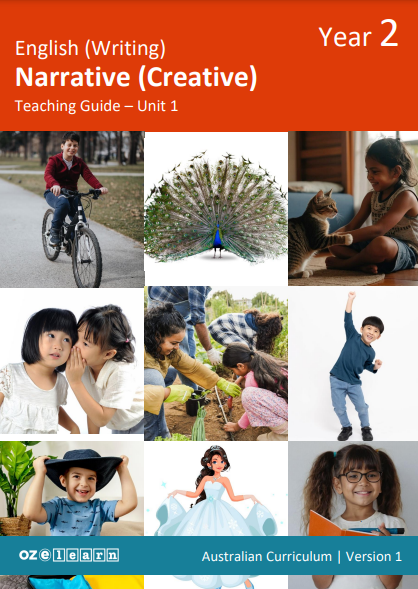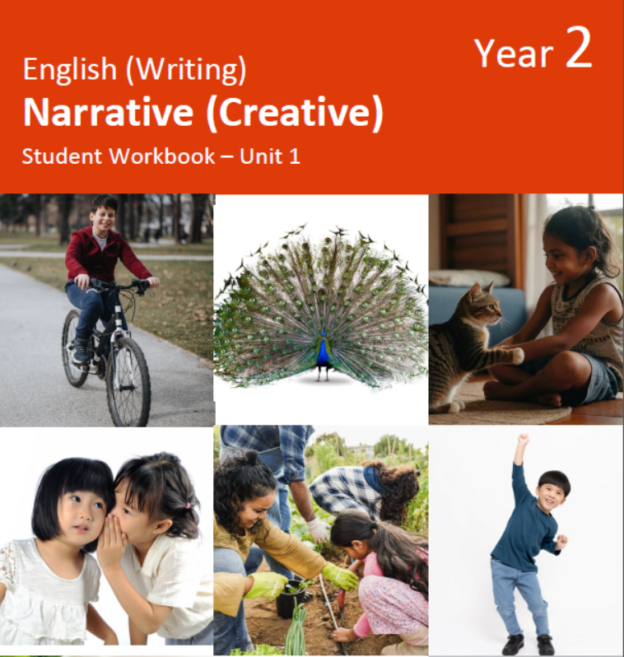Unit 1: Narrative (Creative) Year 2
Oz-e-Writing

Overview
Unit 1 Narrative (Recount) is a writing unit for Year 2 students. It aligns to the Australian Curriculum V9.0.:
- AC9E2LA03 – Identify how texts across the curriculum are organised differently and use language features depending on purposes.
- AC9E2LA04 – Understand how texts are made cohesive by using personal and possessive pronouns and by omitting words that can be inferred.
- AC9E2LA06 – Understand that connections can be made between ideas by using a compound sentence with 2 or more independent clauses usually linked by a coordinating conjunction.
- AC9E2LA07 – Understand that in sentences nouns may be extended into noun groups using articles and adjectives, and verbs may be expressed as verb groups.
- AC9E2LA08 – Understand that images add to or multiply the meanings of a text.
- AC9E2LA10 – Recognise that capital letters are used in titles and commas are used to separate items in lists.
- AC9E2LE01 – Discuss how characters and settings are connected in literature created by First Nations Australians, and wide-ranging Australian and world authors and illustrators.
- AC9E2LE02 – Identify features of literary texts, such as characters and settings, and give reasons for personal preferences.
- AC9E2LE03 – Discuss the characters and settings of a range of texts and identify how language is used to present these features in different ways.
- AC9E2LE05 – Create and edit literary texts by adapting structures and language features of familiar literary texts through drawing, writing, performance and digital tools.
- AC9E2LY02 – Use interaction skills when engaging with topics, actively listening to others, receiving instructions and extending own ideas, speaking appropriately, expressing and responding to opinions, making statements, and giving instructions.
- AC9E2LY05 – Use comprehension strategies such as visualising, predicting, connecting, summarising, monitoring and questioning to build literal and inferred meaning.
- AC9E2LY06 – Create and edit short imaginative, informative and persuasive written and/or multimodal texts for familiar audiences, using text structure appropriate to purpose, simple and compound sentences, noun groups and verb groups, topic-specific vocabulary, simple punctuation and common 2-syllable words.
- AC9E2LY07 – Create, rehearse and deliver short oral and/or multimodal presentations for familiar audiences and purposes, using text structure appropriate to purpose and topic-specific vocabulary, and varying tone, volume and pace.
Success Criteria
- Students understand the purpose of a narrative.
- Students identify the structure of a narrative.
- Students identify the narrative genres: realistic fiction, adventure and fantasy.
- Students understand third person perspectives.
- Students understand simple and compound sentences.
- Students identify the setting within narratives we analyse.
- Students create a setting illustration depicting where and when.
- Learn new vocabulary.
- Students identify and use nouns, proper nouns and adjectives.
- Students use adjectives to write a setting description.
- Students write using third person perspectives.
- Students list verbs that relate to a small problem.
- Students use verbs to write a small problem.
- Students list verbs that relate to a solution.
- Students understand the publishing process.
- Students write a narrative.
- Students give feedback using a sentence starter.
- Students use a rubric to guide their writing.
- Students edit their work.
Learning objectives
In lessons 1 to 45, students learn:
- Different types of narratives.
- The structure of a narrative.
- Settings in a narrative.
- Write a narrative.
- How vocabulary can improve storytelling.
- How to plan, write and edit their own writing.
Teaching resources
- lessons
- Teaching Guide
- marking rubric
- progressive and summative assessments
- Student Workbook
- Student Assessment Workbook.
Assessment
At Year 2 level, students’ progress over the unit can be marked using an A–E achievement scale. The Assessment Rubric is referenced to the Year 1 level achievement standard in the Australian Curriculum 9.0. It incorporates content descriptions and elaborations. Based on evidence teachers make an on-balance judgement to decide which standard of performance the student is achieving. Using the Progress Tests and End of Unit Assessment teachers moderate work and modify the rubric. This will provide qualitive and diagnostic feedback on student learning within the Unit.
A Progress Test will be completed during week 3 and 6 of the unit. Each progress test will include assessment tasks that will assess the content taught during prior weeks. A mark out of 20 will be awarded to each Progress Test.
End of Unit Assessment is to be conducted at the completion of all lessons. A mark out of 60 will be awarded. APPLE questions and Check for Understanding slides provide teachers with the opportunity to assess student understanding at the time of instruction and to drive classroom discussions.



Responses